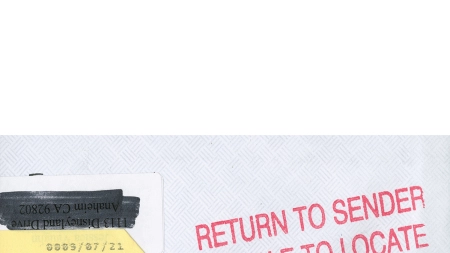
Courtesy the artist
After coming home from a long day’s work, often before entering the front door, we check our mailboxes. We examine their contents with some combination of trepidation and joy, and do with them what we will.
Most people have a very specific relationship to mail, but it’s one they don’t think about a lot. Artist Jessica Vaughn isn’t one of those people.
For this year’s Frieze Artadia commission, Vaughn prods viewers to question the mundane by taking a closer look at the United States Postal Service and the organizational structures that undergird late-stage capitalism.
Vaughn’s new project, titled The Internet of Things (2020–23), involved sending mail through the USPS to historical and contemporary sites of leisure and commerce, as well as places where acts of violence have occurred. These included Disney World and Silicon Valley, along with the site where Martin Luther King Jr. was assassinated in Memphis, the famed arsenal that John Brown raided in Harpers Ferry, West Virginia, and the spot where Trayvon Martin was killed in Sanford, Florida.
“The term ‘Internet of Things’ describes the physical processing of objects and how technology connects to those systems and data, et cetera, so it’s actually a term used specifically within the context of how the mail system sorts materials,” Vaughn told ARTnews. “It felt important to highlight the networking of these sites in respect to how they all communicate with one another within the legacies embedded in their history.”
She started work on the project during the pandemic, when health, wealth, and racial inequities were particularly pronounced. The sites she chose, she added, “all locate themselves around this contemporary present moment.”
When sending the letters, however, Vaughn made sure to tweak the addresses just enough so that they arrived at the location she intended. But, because they were technically incorrect, they were returned to sender, along with marks left on their envelopes by the people and systems that processed them. Vaughn then scanned and enlarged the envelopes to create fabric screenprints.
In this body of work, there’s a tension between manual and mechanized labor. The codes that appear on Vaughn’s letters once had to be memorized by postal workers. Now, they’re simply tracked using computers.
“Workers are always present within the context of machines—they sort of never leave. And all these systems carry the residual aftereffect of those histories,” she explains.

Courtesy the artist
As many Americans struggle post-pandemic to find their footing after losing their loved ones and jobs, and as the threat of ever-developing technology looms large, Vaughn’s work questions where we fit into the current infrastructure.
There’s a “dependence on these structures that you don’t necessarily have immediate access to,” she says, that sometimes involves “working with what’s made available or within [a particular set of] constraints.”
Vaughn herself came up against those constraints. Though sending letters has historically been a way of connecting, the artist said she felt “the distancing that everyone is saying that they have experienced, or continue to experience.” It’s assumed that posting a letter is a personal gesture intended to reach someone far away. The irony, as the codes printed on these envelopes make clear, is that mail is handled impersonally, with minimal human involvement.
Ultimately, “the post office became this way of thinking about site in a very particular way,” Vaughn said. “I wanted to emphasize different sites coming together, where the body is marked through particular historical and contemporary moments.”
Jessica Vaughn‘s Internet of Things will be on view May 17 through 21 as part of Frieze New York at the Shed in New York. A survey of Vaughn’s work, titled “I <3 Customers,” is on view at Kunstverein für die Rheinlande und Westfalen in Düsseldorf through June 4.
Georgia O’Keeffe Made These Works After Going Blind
At Frieze, Dastan Gallery Presents an Intergenerational Grouping of Female Iranian Artists Spanning 100 Years

RobbReport
Pocket Watches From Patek Philippe, Zenith, and More Star in a New N.Y.C. Exhibition

WWD
Waxon, Sous La Face Prep Launch of Co-branded Beauty Destinations

BGR
Netflix might kill its cheapest Basic plan, and I don’t know why it exists to begin with

Sportico
ESPN Extends Reality in New Studio Built With ‘Mandalorian’ Tech

SPY

